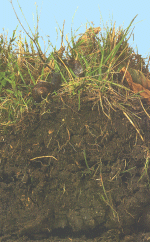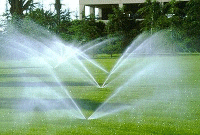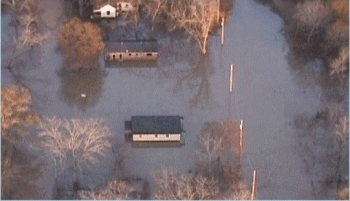



 What is Soil Moisture?
What is Soil Moisture?
Soil moisture is difficult to define because it means different things in
different disciplines. For example, a farmer's concept of soil moisture
is different from that of a water resource manager or a weather forecaster.
Generally, however, soil moisture is the water that is held in the spaces
between soil particles. Surface soil moisture is the water that is in the
upper 10 cm of soil, whereas root zone soil moisture is the water that is
available to plants, which is generally considered to be in the upper 200
cm of soil.
Why is Measuring Soil Moisture Important?
 Compared to other components of the hydrologic
cycle, the volume of soil moisture is small; nonetheless, it of fundamental
importance to many hydrological, biological and biogeochemical processes.
Soil moisture information is valuable to a wide range of government agencies
and private companies concerned with weather and climate, runoff potential
and flood control, soil erosion and slope failure, reservoir management,
geotechnical engineering, and water quality. Soil moisture is a key variable
in controlling the exchange of water and heat energy between the land surface
and the atmosphere through evaporation and plant transpiration. As a result,
soil moisture plays an important role in the development of weather patterns
and the production of precipitation. Simulations with numerical weather
prediction models have shown that improved characterization of surface soil
moisture, vegetation, and temperature can lead to significant forecast improvements.
Soil moisture also strongly affects the amount of precipitation that runs
off into nearby streams and rivers. Large-scale dry or wet surface regions
have been observed to impart positive feedback on subsequent precipitation
patterns, such as in the extreme conditions over the central U.S. during
the 1988 drought and the 1993 floods. Soil moisture information can be used
for reservoir management, early warning of droughts, irrigation scheduling,
and crop yield forecasting.
Compared to other components of the hydrologic
cycle, the volume of soil moisture is small; nonetheless, it of fundamental
importance to many hydrological, biological and biogeochemical processes.
Soil moisture information is valuable to a wide range of government agencies
and private companies concerned with weather and climate, runoff potential
and flood control, soil erosion and slope failure, reservoir management,
geotechnical engineering, and water quality. Soil moisture is a key variable
in controlling the exchange of water and heat energy between the land surface
and the atmosphere through evaporation and plant transpiration. As a result,
soil moisture plays an important role in the development of weather patterns
and the production of precipitation. Simulations with numerical weather
prediction models have shown that improved characterization of surface soil
moisture, vegetation, and temperature can lead to significant forecast improvements.
Soil moisture also strongly affects the amount of precipitation that runs
off into nearby streams and rivers. Large-scale dry or wet surface regions
have been observed to impart positive feedback on subsequent precipitation
patterns, such as in the extreme conditions over the central U.S. during
the 1988 drought and the 1993 floods. Soil moisture information can be used
for reservoir management, early warning of droughts, irrigation scheduling,
and crop yield forecasting.
Remote Sensing of Soil Moisture
 Despite the importance of soil moisture information,
widespread and/or continuous measurement of soil moisture is all but nonexistent.
"The lack of a convincing approach of global measurement of soil moisture
is a serious problem" (National Research Council, 1992). Clearly, a
need exists for continuous measurements of surface soil moisture with global
coverage. Remote sensing of soil moisture from the vantage point of space
is advantageous because of its spatial coverage and temporal continuity,
but this capability does not yet exist. Research in soil moisture remote
sensing began in the mid 1970's shortly after the surge in satellite development.
Subsequent research has occurred along many diverse paths. Quantitative
measurements of soil moisture in the surface layer of soil have been most
successful using passive remote sensing in the microwave region. The potential
exists today to retrieve soil moisture estimates from space-based instruments
at frequencies of about 6 GHz (C band). However, observations at frequencies
between 1 and 3 GHz (L band) are best suited for detection of soil moisture
because energy is emitted from a deeper soil layer and less energy is absorbed
or reflected by vegetation.
Despite the importance of soil moisture information,
widespread and/or continuous measurement of soil moisture is all but nonexistent.
"The lack of a convincing approach of global measurement of soil moisture
is a serious problem" (National Research Council, 1992). Clearly, a
need exists for continuous measurements of surface soil moisture with global
coverage. Remote sensing of soil moisture from the vantage point of space
is advantageous because of its spatial coverage and temporal continuity,
but this capability does not yet exist. Research in soil moisture remote
sensing began in the mid 1970's shortly after the surge in satellite development.
Subsequent research has occurred along many diverse paths. Quantitative
measurements of soil moisture in the surface layer of soil have been most
successful using passive remote sensing in the microwave region. The potential
exists today to retrieve soil moisture estimates from space-based instruments
at frequencies of about 6 GHz (C band). However, observations at frequencies
between 1 and 3 GHz (L band) are best suited for detection of soil moisture
because energy is emitted from a deeper soil layer and less energy is absorbed
or reflected by vegetation.
Soil moisture remote sensing is fraught with challenges. Only the moisture in the top few centimeters of soil can be detected. Algorithm development is complicated by the need for surface roughness and vegetation corrections, which are based on empirical relationships of limited breadth. Extending ground-based techniques to space-based systems requires innovative antenna technology. In spite of these challenges, recent advances in aperture synthesis and thinned array technology applied at L band have shown great promise for soil moisture mapping. Scientists that the Global Hydrology and Climate Center have been involved in experiments to address some the challenges we face in developing this technology.
Responsible Official: Dr. James E. Arnold (jim.arnold@msfc.nasa.gov)
Technical Contact: Charles Laymon (charles.laymon@msfc.nasa.gov)
Page Curator: Diane Samuelson (diane.samuelson@msfc.nasa.gov)
Last Updated: December 30, 1999